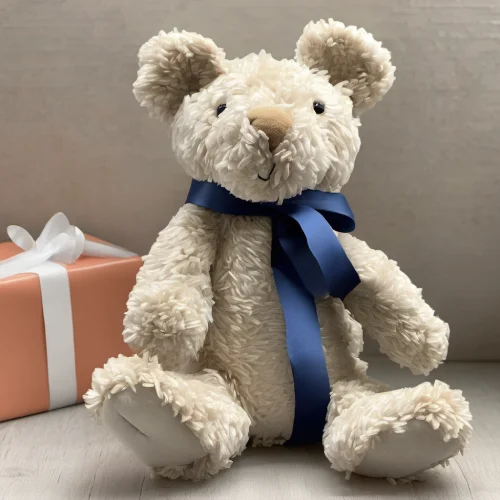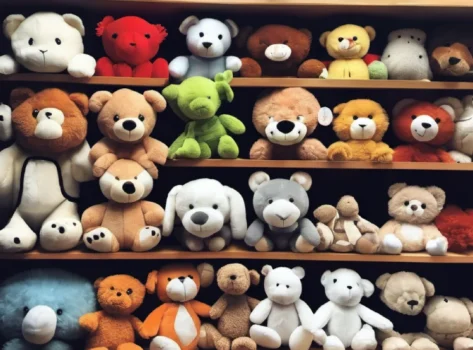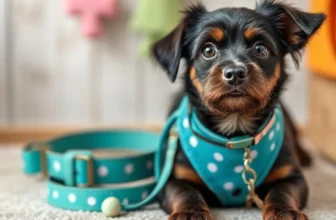Stuffed animals are more than just toys; they’re often cherished companions, offering comfort and companionship to children and even adults. Whether it’s a cuddly teddy bear, a stuffed dog, a stuffed cat, a fluffy bunny, or a quirky plush character, they have a special way of bringing joy and warmth to our lives. Plus, they can be great for imaginative play and can serve as a source of comfort during tough times. Do you have a favorite stuffed animal or a memorable story about one?
How to wash a stuffed animal? How to clean a stuffed animal?
Do you have a custom stuffed animal of your pet to wash? Washing a stuffed animal requires a bit of care to ensure it stays in good condition. Here’s a general guide:
Check the Label: Before washing, always check the care label on the stuffed animal. It may provide specific instructions or warnings about washing.
Spot Cleaning: If the stuffed animal has minor stains or dirt, you can spot clean it with a damp cloth and mild soap. Gently rub the affected areas and then wipe off any soap residue with a clean, damp cloth.
Machine Washing: If the care label allows, you can machine wash the stuffed animal. Here’s how:
- Use a gentle cycle and cold water to prevent damage to the toy.
- Place the stuffed animal in a pillowcase or mesh laundry bag to protect it during washing.
- Use a mild detergent that’s suitable for delicate fabrics.
- Avoid using fabric softeners or bleach, as they can damage the material.
Brushing: Once the stuffed animal is dry, you can gently brush its fur with a soft brush to fluff it up and remove any remaining dirt or debris.
Drying: After washing, gently squeeze out excess water from the stuffed animal. Then, either air dry it by laying it flat on a towel or hanging it in a well-ventilated area away from direct sunlight. Alternatively, you can use a dryer on a low or delicate setting, but be sure to place the stuffed animal in a pillowcase or mesh bag to protect it from the heat and tumbling.
Final Checks: Before returning the stuffed animal to its rightful place, make sure it’s completely dry and free from any detergent residue.
Remember, some stuffed animals with delicate materials or electronic components may not be suitable for washing machines. In such cases, spot cleaning or surface cleaning may be the best option. And always err on the side of caution—if you’re unsure about washing a particular stuffed animal, it’s best to consult with the manufacturer or a professional cleaner.
How to crochet a stuffed animal?
Crocheting a stuffed animal can be a rewarding and creative project. Here’s a basic guide to get you started:
- Choose a Pattern: Start by selecting a crochet pattern for the stuffed animal you want to make. You can find patterns online, in books, or even create your own if you’re experienced.
- Gather Materials: You’ll need yarn in the colors specified by your pattern, as well as an appropriate crochet hook size. You may also need safety eyes or other embellishments, stuffing for the animal, and a yarn needle for sewing pieces together.
- Follow the Pattern: Carefully read through the pattern instructions from beginning to end before you start. Make sure you understand each step and any special techniques required.
- Begin Crocheting: Start by making a slip knot and then chaining the number of stitches indicated in the pattern. From there, follow the pattern instructions for each row or round, working the specified stitches to create the desired shape of your animal.
- Shaping: As you crochet, you’ll likely need to shape the piece by increasing or decreasing stitches in certain areas. This is typically indicated in the pattern instructions.
- Assembly: Once you’ve crocheted all the necessary pieces (body, limbs, head, etc.), it’s time to assemble your stuffed animal. Use your yarn needle to sew the pieces together, following the pattern instructions carefully to ensure proper alignment.
- Stuffing: Once the main body of the animal is assembled but not completely closed, stuff it with the stuffing material. Be sure to stuff it firmly enough to give it shape, but not so tightly that it distorts the crochet stitches.
- Finishing Touches: After stuffing, complete any remaining crocheting required to close up the openings. Then, add any embellishments like eyes, noses, or other features as specified in the pattern.
- Final Checks: Before considering your stuffed animal complete, give it a once-over to ensure all pieces are securely attached and any loose ends are woven in and trimmed.
- Enjoy!: Once your stuffed animal is finished, take a moment to admire your handiwork and enjoy the satisfaction of bringing your creation to life.
Remember, crocheting a stuffed animal may take time and practice, especially if you’re new to the craft. Don’t be discouraged if it doesn’t turn out perfectly on your first try—each project is a learning experience, and with practice, your skills will improve. Have fun and let your creativity shine!

How to wrap a stuffed animal
How to wrap a stuffed animal?
Wrapping a stuffed animal can make it an even more special gift for someone. Here’s a guide on how to do it:
Select wrapping paper that suits the occasion and the recipient’s preferences. You can opt for colorful, patterned paper or something more elegant and simple.
If the stuffed animal is particularly large or has protruding parts like ears or tails, you may want to position it in a way that makes it easier to wrap. For example, you could lay it flat on its back or tuck its limbs in to create a more compact shape.
Place the stuffed animal in the center of the wrapping paper. Fold one side of the paper over the toy and secure it with tape or adhesive. Then, fold the other side over and secure it as well. Make sure the paper is snug around the toy but not too tight to avoid squishing it.
Fold the ends of the wrapping paper as you would when wrapping a regular gift box. You can create neat triangular folds by pressing the paper inward and then folding it over the ends of the toy. Secure the folds with tape or adhesive.
If you’re giving the wrapped stuffed animal as a gift, you can attach a gift tag with a personalized message. Write the recipient’s name on the tag and any other message you’d like to include.
Before presenting the wrapped stuffed animal, take a moment to inspect your wrapping job. Make sure all the folds are secure and the tape or adhesive is holding everything in place. Adjust any areas that need tidying up.
Now that your stuffed animal is beautifully wrapped, it’s ready to be presented to the lucky recipient. Whether it’s for a birthday, holiday, or special occasion, your thoughtfully wrapped gift is sure to bring joy and excitement.
Wrapping a stuffed animal is a simple yet effective way to make it feel like an extra special gift. Have fun with the process and get creative with your wrapping paper and decorative accents!
When can a baby sleep with a stuffed animal?
It’s generally recommended to wait until a baby is at least 12 months old before introducing a stuffed animal or any other soft object into their crib during sleep. This recommendation is based on safety guidelines to reduce the risk of suffocation and other sleep-related hazards.
Before the age of 12 months, the American Academy of Pediatrics (AAP) advises that the baby’s sleep environment should be free of any soft objects, loose bedding, or plush toys to minimize the risk of accidental suffocation or sudden infant death syndrome (SIDS). Babies at this age are still developing their motor skills and may not have the ability to move objects away from their face if they become trapped.
Once a baby reaches the age of 12 months and has developed the strength and coordination to move objects away from their face, it may be safe to introduce a small, soft stuffed animal or lovey into their sleep environment. However, it’s essential to choose a stuffed animal that is specifically designed for infants and meets safety standards, such as having no small parts that could pose a choking hazard.
How to make a stuffed animal weighted?
Adding weight to a stuffed animal like dogs, or cats can provide a comforting sensation, especially for individuals who benefit from sensory input or who use weighted items for therapeutic purposes.
Select a suitable filler material to add weight to the stuffed animal. Common options include small plastic pellets (such as polypropylene or polyethylene pellets), glass beads, rice, or dried beans.
Begin by preparing the stuffed animal you want to make weighted. If you’re making the stuffed animal from scratch, you can incorporate the weighted filler material into the design as you sew the pieces together. If you’re adding weight to an existing stuffed animal, you’ll need to create pockets or compartments to hold the weighted material.
Carefully fill the pockets or compartments with your chosen weighted material. Use a funnel or scoop to make the process easier and to prevent spills. Be sure to distribute the weight evenly throughout the stuffed animal to maintain balance.
Once the pockets are filled with the weighted material, securely close the openings using a needle and thread or a sewing machine. Make sure the stitches are tight and secure to prevent the weighted material from escaping.
It’s important to note that when making a weighted stuffed animal, you should consider the recipient’s preferences and any specific sensory needs they may have. Additionally, be cautious not to add too much weight, as it may make the stuffed animal too heavy or difficult to handle. If you’re unsure about the amount of weight to add or have any concerns, it’s always a good idea to consult with a healthcare professional or therapist for guidance.
What is the biggest stuffed animal in the world?
As of my last update in January 2022, the Guinness World Record for the largest stuffed animal was held by a teddy bear named “Joyce,” created by Christopher Davenport (UK). This massive teddy bear measured 20.09 meters (65 feet 11.6 inches) in length. It was unveiled in New York, USA, on 28 October 2018.
However, it’s worth noting that records like these may be subject to change over time as new attempts are made to break them. So, there might be a larger stuffed animal that has claimed the title since then. Always a good idea to check the latest records with Guinness World Records for the most up-to-date information.








